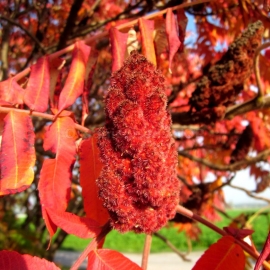






Organic Staghorn Sumac Seeds (Rhus Typhina)
1.14 €
Hairy stems that support an umbrella-like crown of feathery foliage, staghorn sumac displays a handsome red fruit spike and yellow, red and orange fall color. A deciduous, upright, colonizing large shrub, it is native to much of eastern North America.
-
Organic Staghorn Sumac (Rhus Typhina)
Hairy stems that support an umbrella-like crown of feathery foliage, staghorn sumac displays a handsome red fruit spike and yellow, red and orange fall color.
A deciduous, upright, colonizing large shrub, it is native to much of eastern North America. It often looks like a multi-stemmed, flat-canopy small tree. Although the bark is smooth and sandy brown, younger twigs are more reddened with a brown fuzz. In late spring the dark green foliage appears. Leaves are held at tops of branches in a layered whorl.
Each long, feather-like, compound leaf is made up of many narrow, jagged-edged leaflets. In early summer a tufted spike of creamy yellow-green flowers appears at branch tips, and will become an attractive cluster of crimson red fruits on female plants by early autumn.
The leaves turn yellow in fall and usually have blushes of orange or becoming nearly fully red. Grow the heat and cold tolerant staghorn sumac in full to partial sun in any average, well-draining soil. As it suckers and creates a small thicket of tall trunks, use it as a windbreak or specimen at the edge of a woodland. It can also aid in hill stabilization and for providing cover for birds and wildlife.
How to Grow
Staghorn Sumac seeds have a natural dormancy within them, this requires a degree of patience to overcome and it is usually quite easy to get high levels of germination if the correct procedures are followed. First soak the seeds in close to boiling hot water, allow to cool and leave them soaking for 24 hours. When this is completed drain away all the water fully.
Next prepare a free draining substrate into which the seeds are to be mixed, moist sand is thought to give the best results for this although you could use a 50/50 mixture of compost and sharp sand, The chosen substrate needs to be moist (but not wet), if you can squeeze water out of it with your hand it is too wet and your seeds may drown and die.
Mix the seeds into the substrate, making sure that their is enough volume of material to keep the seeds separated. Place the seed mixture into a clear plastic bag (freezer bags, especially zip-lock bags are very useful for this -provided a little gap is left in the seal for air exchange) If it is not a zip-lock type bag it needs to be loosely tied. Then write the date on the bag so that you know when the pretreatment was started.
The seeds require a cold period to break the dormancy that is naturally found within them, this is easily achieved by placing the prepared bag of seeds and compost mix in the fridge (4 Celsius or 39F) for around 4 weeks or so. It is quite possible for the seeds to germinate in the bag at these temperatures when they are ready to do so, if they do, just remove them from the bag and carefully plant them up.
For larger quantities it is easiest to sow the seeds in a well prepared seedbed once the cold pretreatment has finished and wait for the seeds to germinate. Seeds that are ready to germinate will be plump and soft, if they are not, the pretreatment is not yet complete or has been ineffective due to incorrect temperatures or incorrect moisture content of the pretreatment medium and the pre treatment process should be started again.
Do not expose newly sown seeds to high temperatures (above 25 Celsius) otherwise a secondary dormancy may be induced and the seeds will not germinate until they have been pretreated again. Germinated seeds can be planted in deep pots or plug trays in a good quality compost. Keep the seedlings well watered and weed free.
Growth in the first year is usually between 20 and 40 cm and usually trouble free. Growth accelerates rapidly in the second year. Allow them to grow for 1 or 2 years before planting them in a permanent position.
